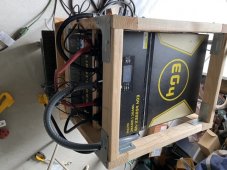Robkh
New Member
Set up EG4 6500 inverter on a cart with 48V Lifepower battery to use for powering my RV off grid. I had wired a 30A RV style plug for direct AC input - when I called Signature Solar, tech recommended I not directly wire the plug to the AC in on the inverter and instead put an intervening breaker box. That is not something I see others have done. I don’t have enough PV to push the minimum 90V that the EG4 6500 requires so I need to plug in to charge the Lifepower battery. Any thoughts on the breaker box?
I also have a 48V battery charger but Signature Solar recommends not keeping the charger connected to the battery and taking off the connections by undoing the lugs after each charge. Any comments about why I can’t leave the charger connected?

I also have a 48V battery charger but Signature Solar recommends not keeping the charger connected to the battery and taking off the connections by undoing the lugs after each charge. Any comments about why I can’t leave the charger connected?







